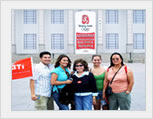
Chinese Characters
 The Chinese languages are the languages of the Han people, the major ethnic group of China, and consist of a great many dialects. Chinese languages is estimated that over 1 billion people speak a form of Chinese, being some 95% of the population. Other non-Chinese languages spoken include Tibetan, Mongolian, Lolo, Miao, and Tai. The number of Chinese characters contained in the Kangxi dictionary is approximately 47,035, although a large number of these are rarely used variants accumulated throughout history. Studies carried out in China have shown that literacy in the Chinese language requires a knowledge of only between three and four thousand characters. In the Chinese writing system, the characters are morphosyllabic, each
The Chinese languages are the languages of the Han people, the major ethnic group of China, and consist of a great many dialects. Chinese languages is estimated that over 1 billion people speak a form of Chinese, being some 95% of the population. Other non-Chinese languages spoken include Tibetan, Mongolian, Lolo, Miao, and Tai. The number of Chinese characters contained in the Kangxi dictionary is approximately 47,035, although a large number of these are rarely used variants accumulated throughout history. Studies carried out in China have shown that literacy in the Chinese language requires a knowledge of only between three and four thousand characters. In the Chinese writing system, the characters are morphosyllabic, each
 usually corresponding to a spoken syllable with a basic meaning. However, although Chinese words may be formed by characters with basic meanings, a majority of words in Mandarin Chinese require two or more characters to write (thus are poly-syllabic) but have meaning that is distinct from the characters they are made from.[2] Cognates in the various Chinese languages/dialects which have the same or similar meaning but different pronunciations can be written with the same character. The Written Chinese Language :Mainland China uses a simplified form of writing but the traditional script is still in use in such places as Taiwan and Hong Kong. During the latter half of the nineteenth century, A movement for reform began that wished to see
usually corresponding to a spoken syllable with a basic meaning. However, although Chinese words may be formed by characters with basic meanings, a majority of words in Mandarin Chinese require two or more characters to write (thus are poly-syllabic) but have meaning that is distinct from the characters they are made from.[2] Cognates in the various Chinese languages/dialects which have the same or similar meaning but different pronunciations can be written with the same character. The Written Chinese Language :Mainland China uses a simplified form of writing but the traditional script is still in use in such places as Taiwan and Hong Kong. During the latter half of the nineteenth century, A movement for reform began that wished to see
 literacy rates increase and saw the traditional script as a barrier to this goal. This movement grew in strength after the formation of the PRC. The first of the simplifications took place in 1955 which eliminated over 1,000 characters. This was followed by another simplification in 1956, called the First Scheme. Spoken Chinese comprises many regional dialects. However, the mutual unintelligibility of the sub varieties in Chinese Language is the main ground for classifying them as separate languages or dialect groups. Each dialect group consists of a large number of sub dialects, many of which may themselves be referred to as languages.
literacy rates increase and saw the traditional script as a barrier to this goal. This movement grew in strength after the formation of the PRC. The first of the simplifications took place in 1955 which eliminated over 1,000 characters. This was followed by another simplification in 1956, called the First Scheme. Spoken Chinese comprises many regional dialects. However, the mutual unintelligibility of the sub varieties in Chinese Language is the main ground for classifying them as separate languages or dialect groups. Each dialect group consists of a large number of sub dialects, many of which may themselves be referred to as languages.
Your Question & Quick Answer*We welcome and appreciate your questions & reviews
User Comments
Booking Procedures | Terms & Conditions | Payment Methods | Links | Site Map | About Us | Contact Us | Travel Agent
Copyright 2008, All rights reserved.. itourbeijing.com ,china culture, china introduction
TEL: 86-10-85711972 (Universal) 1-888-288-9328 (North America) E-mail: contact@itourbeijng.com
Home | China Tours | Beijing Tours | Tibet Tours | China Travel | Beijing Travel | Shanghai Travel



